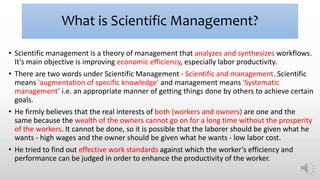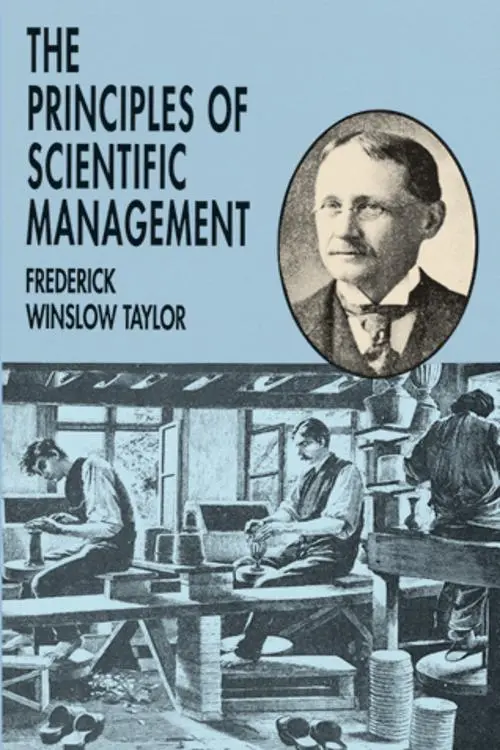
Introduction to Taylor Scientific Management Theory
Taylor Scientific Management Theory, developed by Frederick Winslow Taylor in the late 19th century, revolutionized the way work was conducted in factories and organizations. This theory aimed to increase efficiency and productivity by applying scientific methods to workplace management. Taylor’s principles have had a significant impact on the workplace and continue to influence management practices to this day.
Overview of Frederick Winslow Taylor and his principles
Frederick Winslow Taylor, an American engineer, is often referred to as the ‘father of scientific management.’ He believed that inefficiencies in the workplace could be overcome by implementing a systematic approach based on scientific analysis and measurement. Some of his key principles include:
- Time and motion studies: Taylor analyzed every job and broke it down into individual tasks. He measured the time required for each task and identified ways to standardize and optimize processes.
- Task specialization: Taylor emphasized dividing work into smaller specialized tasks, assigning each worker a specific task based on their skills and training. This division of labor allowed workers to perform tasks more efficiently.
- Incentives and motivation: Taylor proposed that workers should be rewarded for meeting or exceeding performance standards. He introduced a piece-rate system where workers received additional pay based on their output level, thus providing motivation for higher productivity.
- Standardization: Taylor advocated for standardizing tools, equipment, and work procedures to eliminate variations and increase efficiency.
- Close supervision: Managers were expected to closely supervise workers, provide guidance, and ensure compliance with established procedures.
Taylor’s principles transformed how work was organized, increasing productivity and efficiency in factories worldwide. However, his theories also faced criticism for their focus on task specialization and stringent control over workers.
In conclusion, Taylor Scientific Management Theory revolutionized the workplace by introducing scientific methods and systematic approaches to management. This theory laid the foundation for modern management practices and continues to shape how organizations operate today. Understanding Taylor’s principles can help businesses improve efficiency, productivity, and overall performance in the workplace.

Taylor Scientific Management Theory: The Impact on the Workplace
Frederick Taylor’s Scientific Management Theory, also known as Taylorism, revolutionized the way businesses operate and greatly influenced modern management practices. Developed in the early 20th century, this theory emphasizes efficiency, productivity, and standardization. Let’s take a closer look at the key principles of Taylor’s theory and their impact on the workplace.
1. Time and motion study
Taylor believed in breaking down work processes into individual tasks and analyzing them to determine the most efficient way to perform each task. This approach, known as time and motion study, enabled managers to optimize productivity by eliminating unnecessary movements and streamlining workflow.
2. Division of labor and specialization
By dividing tasks into smaller, specialized units, Taylor aimed to increase efficiency and productivity. Each worker would focus on a specific task in which they had expertise, resulting in higher quality output and faster completion times.
3. Standardization and efficiency
Taylor advocated for standardized work methods and equipment to ensure consistent quality and efficiency. Standardization also allowed organizations to train workers quickly and easily replace them if needed, reducing downtime and increasing productivity.
4. Scientific selection and training
Taylor emphasized the importance of selecting workers based on their suitability for a specific task. He believed that employees should be trained not only in their technical skills but also in the most efficient methods of performing their tasks. This scientific approach to selection and training aimed to maximize productivity.
5. Incentives and motivation
Taylor recognized the role of motivation in increasing workers’ productivity. He proposed that financial incentives, such as piece-rate pay or bonuses for exceeding targets, would motivate employees to work harder and produce more output.
Overall, Taylor’s Scientific Management Theory had a profound impact on the workplace. It transformed organizations by emphasizing efficiency, standardization, and employee specialization. While Taylor’s approach has faced criticism over time for its potential to dehumanize work and overlook the importance of employee satisfaction, many of his principles continue to shape modern management practices.

Impact of Taylor Scientific Management Theory on the Workplace
Fredrick Taylor’s scientific management theory revolutionized the way businesses operate and had a profound impact on the workplace. Let’s explore some key aspects of this theory and how it transformed organizations.
1. Increased productivity and efficiency
Taylor believed that by analyzing work processes scientifically, companies could identify inefficiencies and eliminate them. This approach led to increased productivity as workers focused on tasks that provided the most value. Performance improved as employees were trained in efficient techniques and provided with the necessary tools and resources.
2. Streamlined workflows and processes
By breaking down tasks into individual components, Taylor’s theory allowed for the standardization of work processes. This meant that tasks could be performed consistently, leading to better quality outputs. Additionally, managers could identify bottlenecks or areas of improvement more easily, resulting in streamlined workflows.
3. Clear job descriptions and performance expectations
Taylor emphasized the importance of clear job descriptions and performance expectations for employees. This clarity ensured that everyone understood their roles and responsibilities within the organization. By setting specific targets and implementing a system to measure performance, managers could hold employees accountable for their work.
4. Managerial control and supervision
One of the core principles of Taylor’s theory was the idea of managerial control and supervision. Managers were seen as experts who had better knowledge of work processes than workers. They played a vital role in planning and coordinating tasks, directing employees’ efforts towards organizational goals, and ensuring adherence to standard procedures.
Overall, Taylor’s scientific management theory revolutionized the workplace by focusing on increasing productivity, streamlining workflows, providing clear job descriptions, and emphasizing managerial control. Although some critics argue that it dehumanized work or neglected employee satisfaction, Taylor’s principles laid the foundation for modern management practices, influencing industries worldwide and paving the way for further advancements in organizational efficiency and effectiveness.

Criticisms and Limitations of Taylor Scientific Management Theory
Despite its contributions to management practices, Taylor’s Scientific Management Theory is not without its criticisms and limitations. Let’s explore some of the key areas where this theory falls short:
1. Overemphasis on efficiency at the expense of worker well-being
Taylor’s approach focused primarily on maximizing efficiency and productivity in the workplace. While this led to improvements in output, it often ignored the impact on worker well-being. The relentless pursuit of efficiency sometimes led to extreme measures that disregarded employees’ physical and psychological health.
2. Lack of consideration for human factors and creativity
Taylor’s scientific approach tended to view workers as mere cogs in a machine, emphasizing standardized processes to eliminate variability. This approach failed to recognize the importance of human factors and creativity in the workplace. By not tapping into the full potential of employees, the theory limited innovation and stifled individual growth.
3. Resistance from workers and unions
Taylor’s methods often faced significant resistance from workers and labor unions. His focus on breaking down tasks into repetitive motions and minimizing employee discretion resulted in dehumanized work environments. This sparked resentment and led to protests, strikes, and conflicts between management and labor.
4. Applicability in certain industries and work environments
Although Taylor’s principles brought advantages to manufacturing industries with repetitive tasks, they may not be as applicable to industries that require more flexibility, creativity, and collaboration. The theories’ narrow focus on efficiency may not align with the complex demands of today’s knowledge-based economy.
While Taylor’s Scientific Management Theory made important contributions to efficiency and productivity, it is crucial to acknowledge its limitations. Management approaches have changed to include a broader perspective that values employee well-being, creativity, and collaboration as important parts of a successful workplace.

Contemporary Relevance of Taylor Scientific Management Theory
Taylor Scientific Management Theory, developed by Frederick Taylor in the early 20th century, revolutionized the way work was organized and managed. Though it was presented over a century ago, its principles continue to shape contemporary management practices. Let’s explore the impact of Taylor’s theory on the workplace today.
1. Influence on modern management practices
Taylor’s theory emphasized efficiency, productivity, and standardization in the workplace. These principles are still highly valued today and have been adopted by organizations worldwide. Some ways in which Taylor’s theories influence modern management practices include:
- Time and motion studies: Taylor introduced systematic observations and measurements to identify the most efficient ways of performing tasks. Today, organizations use similar techniques such as work measurement and process analysis to optimize productivity.
- Specialization: Taylor advocated for breaking down complex tasks into smaller, specialized tasks to increase efficiency. This concept has been incorporated into modern job design, where employees often have specialized roles that contribute to overall organizational goals.
2. Integration with other management theories
While Taylorism alone may not fit all modern workplaces, its principles have been integrated with other management theories to create more well-rounded approaches. For example:
- Lean manufacturing: Taylor’s focus on eliminating waste and improving efficiency aligns with lean manufacturing principles. Both theories prioritize continuous improvement and waste reduction.
- Human relations theory: Taylor’s work helped pave the way for the human relations movement, which emphasizes the importance of employee satisfaction and motivation. While Taylorism focused primarily on optimizing tasks, modern management theories acknowledge the need for a balance between task efficiency and employee well-being.
3. Lessons for organizational success
Taylor’s theory offers valuable lessons for achieving organizational success today:
- Clear goals and standards: Setting clear expectations and performance standards ensures that employees know what is expected of them and allows for better progress monitoring.
- Continuous improvement: Taylor’s focus on finding the most efficient methods can be applied to all aspects of an organization. Striving for continuous improvement helps organizations stay competitive and adapt to changing market conditions.
In conclusion, Taylor Scientific Management Theory continues to have a significant impact on contemporary management practices. Its emphasis on efficiency, specialization, and standardization aligns with the goals of many organizations today. By integrating Taylor’s principles with other management theories and adopting lessons for success, organizations can create effective and productive workplaces.
Conclusion
In conclusion, Taylor’s Scientific Management Theory had a significant impact on the workplace and continues to influence management approaches today. This theory emphasized the importance of efficiency, standardization, and task specialization in increasing productivity. The key points discussed are summarized below:
Summary of the impact of Taylor Scientific Management Theory on the workplace
- Introduced time and motion studies to identify the most efficient way to perform tasks.
- Emphasized dividing work into small and specialized tasks to maximize efficiency.
- Implemented a hierarchical structure with clear lines of authority.
- Focused on closely supervising workers to ensure adherence to established procedures.
- Promoted monetary incentives as a motivation for increased productivity.
Evaluation of its strengths and weaknesses
Strengths:
- Increased productivity and efficiency in manufacturing industries.
- Standardized processes resulted in consistent outputs.
- Emphasized the importance of scientific observations and measurements.
Weaknesses:
- Neglected the human aspects of work, leading to dissatisfaction among employees.
- Overlooked the significance of individual skills, creativity, and problem-solving abilities.
- Limited worker autonomy and opportunities for growth.
Implications for future management approaches
Taylor’s Scientific Management Theory laid a foundation for future management approaches by recognizing the need for systematic processes and efficiency. However, it also highlighted the importance of considering human factors in the workplace. Subsequent management theories have integrated elements of both scientific management principles and a focus on employee well-being. Future management approaches should balance efficiency and employee satisfaction to create a harmonious and productive workplace.
In conclusion, Taylor’s Scientific Management Theory was a significant milestone in management thinking. While it achieved remarkable improvements in productivity, it also raised concerns about its impact on employee well-being. By incorporating lessons learned from this theory, future management approaches can aim for greater effectiveness, employee satisfaction, and organizational success.




